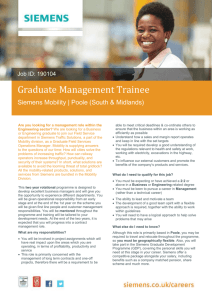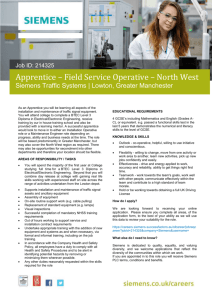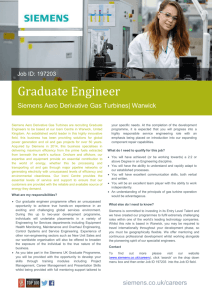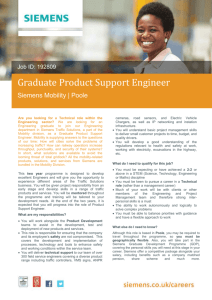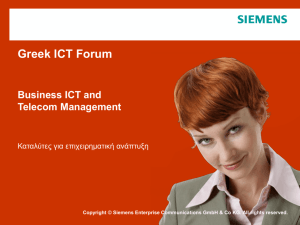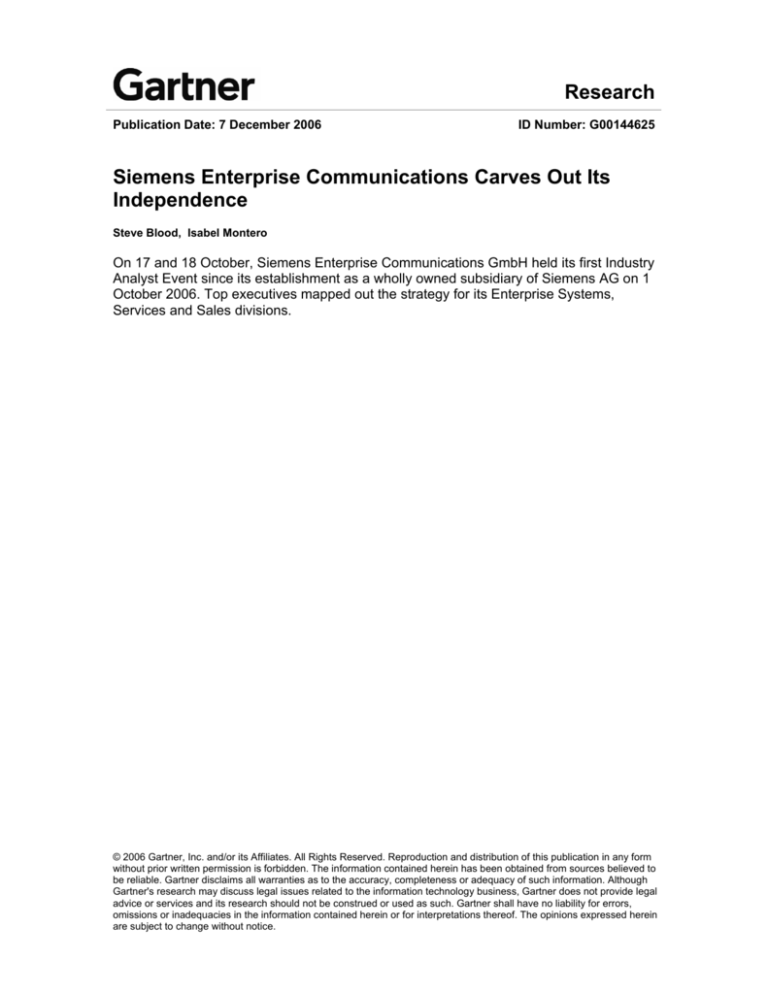
Research
Publication Date: 7 December 2006
ID Number: G00144625
Siemens Enterprise Communications Carves Out Its
Independence
Steve Blood, Isabel Montero
On 17 and 18 October, Siemens Enterprise Communications GmbH held its first Industry
Analyst Event since its establishment as a wholly owned subsidiary of Siemens AG on 1
October 2006. Top executives mapped out the strategy for its Enterprise Systems,
Services and Sales divisions.
© 2006 Gartner, Inc. and/or its Affiliates. All Rights Reserved. Reproduction and distribution of this publication in any form
without prior written permission is forbidden. The information contained herein has been obtained from sources believed to
be reliable. Gartner disclaims all warranties as to the accuracy, completeness or adequacy of such information. Although
Gartner's research may discuss legal issues related to the information technology business, Gartner does not provide legal
advice or services and its research should not be construed or used as such. Gartner shall have no liability for errors,
omissions or inadequacies in the information contained herein or for interpretations thereof. The opinions expressed herein
are subject to change without notice.
WHAT YOU NEED TO KNOW
Siemens' Communications Group has undergone major changes during the past year. The
separation of the Enterprise and Carrier divisions will create a partnership for the latter with Nokia
Siemens Networks, but negotiations to find a majority partner or investor for the Enterprise
division are ongoing. The fraud investigations are damaging, but not fatal, for Siemens AG and
will have little impact on Enterprise division. This also has no effect on the product road map, and
we fully expect Siemens AG to stand behind its Communications business.
The creation of Siemens Enterprise Communications better positions the company for the
partnerships it seeks. It also provides an opportunity for management and employees to
collectively focus on strengthening sales and marketing, as well as improving profitability to make
EC a more attractive partner. However, the management needs to act quickly to remove any
uncertainties about near- and long-term partnerships. We anticipate that Siemens AG will find a
buyer before the end of 1Q07 or expect to have ownership of EC for the next two or more years.
Anything in between will result in disillusioned employees and perplexed customers.
EVENT
Event Facts
Siemens Enterprise Communications (EC) has created a matrix business by initiating separate
lines of business for Systems (headed by Thomas Zimmerman) and Services (headed by
Gerhard Otterbach), each with its own global marketing function. These business units feed a
sales business focused on the top 100 strategic accounts, headed by Stefan Herrlich; a direct
touch group, run by Bob Thompson; and a channels business, run by Stefan Grinzinger. The
senior management team is headed by CEO Andreas Bernhardt and includes CFO Reinhard
Benditte.
Streamlining of the business has resulted in a head count reduction of 2,000 in 2006, mainly in
Germany, producing a total workforce of around 17,000. Some of this reduction has come from
the sale of its Small and Midsized Business unit in Switzerland to Swisscom and in the
Netherlands to KPN. Further realignment is expected to support the go-to-market strategy, which
means EC will shift the majority of its low-end business to channel. Historically, EC has always
communicated this strategy, but execution has proved challenging. The new management team
has indicated that it is focused on this strategy, and has also presented the parallel objective of
growing its business in North America and, particularly, the Asian markets.
The HiPath 8000 was high on the product agenda, with presentations covering future direction
and a customer case study. The most important information described the ownership of the
intellectual property of the baseline product. As of 1 October 2006, EC owns the rights to the
entire product portfolio, which will be separated from the hiQ 8000 development in July 2007. A
mobility strategy highlighted a key weakness in providing integration between cellular telephones
and the IP-PBX. Avaya, Cisco and Alcatel have announced partnerships with Nokia. Siemens'
reason for not developing specific partnerships was ongoing discussions with potential business
partners.
OpenScape also took center stage, with Accenture describing how OpenScape has been natively
integrated into line of business applications, such as Siebel e-clinical, Salesforce.com, and
applications or software solutions. This provides an embedded presence and context awareness
applicable to each stage of the business application.
Publication Date: 7 December 2006/ID Number: G00144625
© 2006 Gartner, Inc. and/or its Affiliates. All Rights Reserved.
Page 2 of 6
EC also announced the introduction of its new IP telephone portfolio. The OpenStage Session
Initiation Protocol (SIP) phones include Web services interfaces and multivendor SIP-based
interoperability. The new models are due for launch on 11 December 2006, and, although the
indicative list pricing was given at the event, we have been asked not to reveal these until the
launch. These devices have been designed for the HiPath 8000; however, they can be deployed
with the HiPath 4000 with SIP, as part of the transition plan to the HiPath 8000, but with a limited
feature set.
Siemens has actively certified third-party SIP handsets for connection to the HiPath 8000,
proposing that customers chose which handsets they use, and indicated that they will not be
unduly penalized with premium SIP licenses. EC devices will be manufactured in Germany to
stock large quantities of the devices ready for deployments in the European market. An executive
indicated that EC wants to remain loyal to its local customers by providing them with a locally
manufactured product.
The product and service marketing strategy was given only minimal focus compared with the time
spent on product capabilities and developments. The OpenPath message used throughout the
event was given special attention. Some promotional plans and materials were shared, but the
details of how EC was going to create its own brand, as well as the investments it was prepared
to make to achieve that goal, were not provided.
Analysis
The separation of the Systems and Services business units ensures that each can pursue
individual directions for the benefit of the business unit. Most importantly, much of the channel
conflict evident under previous leadership is removed as Thomas Zimmerman's Systems
business unit takes ownership of channels. In addition to Enterprise Services as a channel, it may
seek other channels to fulfill the sale of its portfolio. Equally, Enterprise Services has a level of
autonomy to deliver solutions pertinent to customer requirements. Although Gerhard Otterbach
stated the business unit is not going to be a reseller of third-party products, it has the latitude to
select the relevant technologies to meet customer needs.
With potentially more players offering the HiPath portfolio, companies will have greater choice of
supplier. Competition ensures EC maintains the highest levels of service and support, something
it has been criticized for in the past, especially in markets such as the U.S., where customer
experience is still challenged.
The sale of Siemens Small and Midsized Business units in Switzerland and Netherlands is a
positive move. EC struggles to serve this group of customers profitably, so disposal to a third
party will reduce overhead and represent a more profitable model for EC overall. It will also help
improve channel relationships in markets where it has been in competition. This will be achieved
more quickly than the largely unsuccessful channel transition strategy of previous years.
Profitability will be affected positively by these moves; however, it's likely that Siemens will
require further head count reductions to improve revenue per head (which is below €200,000).
The desire to expand its business further in North America and into the Asian markets cannot be
achieved quickly without acquisition, yet this would push EC further into debt. Consequently, we
expect it to continue with an organic growth strategy, while continuing to look for a partner that is
stronger in the target markets. Companies can expect Siemens to continue its focus primarily on
European-based (especially Germany) multinationals.
When Siemens' Carrier business was merged with Nokia, it retained ownership of the SURPASS
hiQ 8000. (Gartner highlighted concerns in "Enterprise HiPath 8000 Customers Should Seek
Commitment.") However, an agreement was reached at the end of September 2006 in which EC
would take equal ownership of the baseline product, software streams and gateway portfolio. The
Publication Date: 7 December 2006/ID Number: G00144625
© 2006 Gartner, Inc. and/or its Affiliates. All Rights Reserved.
Page 3 of 6
software will be separated in July 2007 with the next HiPath 8000 release. This will give EC
exclusive rights to its own product platform.
Although EC and Nokia-Siemens Networks may continue joint development, neither partner is
relying on the other. The agreement was not wholly unexpected, but our concern at the time of
the split was that, if Enterprise secured a majority-share partner in the same time frame as the
Nokia-Siemens partnership, this could lead to a conflict of intellectual license. Nokia-Siemens
Networks wouldn't want a competitor to have its source code. This resolution ensures that EC
can proceed as an independent body, either as a subsidiary of Siemens AG or in partnership with
another player. It also confirms Siemens' continued commitment to the HiPath 8000.
The decision not to develop a tighter integration with mobile handset vendors is short-sighted,
even given the ongoing partnership negotiations. EC could limit its exposure by formalizing a
partnership with a provider such as onRelay. Siemens Switzerland has already certified this
solution to work with the HiPath 4000, but both companies could gain more corporately from a
stronger partnership.
Companies that require a tight integration between wired and wireless telephony should look
closely at the solution from onRelay. Although HiPath 4000 didn't figure in presentations, it will
still be a key component of EC's success in migrating customers. There are differences in the
feature sets of the two platforms, so companies should insist that Siemens demonstrate a smooth
migration plan.
A key strength of the OpenScape product is that Siemens can show how it is complementary to
Microsoft Office Communications Server (OCS), providing multiparty conference across any
medium and user channel preference. It also demonstrates important integration with business
application software. Microsoft has not integrated OCS with competitors such as Siebel and
Salesforce.com, whereas EC has demonstrated with Accenture that it is a leader in business
application integration. Companies looking to leverage a closer link between communications and
business process should consider OpenScape a viable platform, regardless of the current
communications provider (see "Magic Quadrant for Unified Communications, 2006").
The OpenStage SIP devices are welcome, but Siemens is late to market to gain inroads in XMLbased IP phones. The release of its new phones is three years behind its competitors, but it's
encouraging that EC is enabling companies to connect third-party devices to the HiPath 8000.
Suppliers need the income from proprietary handsets, and charge a premium license for thirdparty units to discourage the activity. Although Siemens' position is highly commendable,
companies investing in HiPath should obtain contractual commitment to keeping this, because it's
possible EC could reverse itself in the face of decreasing handset revenue.
The strategy for manufacturing OpenStage handsets in Germany is seriously flawed, especially in
light of the BenQ-Siemens mobile handset fiasco. Europe simply cannot compete with Asia on
manufacturing costs. Siemens has some innovation in the new devices, but, at the indicated
prices, it is unlikely to secure sufficient volume to continue production in Germany. Companies
should calculate carefully the cost benefit of these handsets, especially the high-end units. We
believe there's a risk OpenStage that may not be in production for a long period. Companies can
also look at third-party handsets and should consider our advice relating to screen phones next to
PCs (see "Don't Purchase IP Screen Phones If You Have a PC on Your Desk").
Like most engineering-led companies, Siemens hasn't had a comprehensive marketing strategy.
The communications market has moved beyond a time when business was won on great
technology and feature differentiation. Although EC has some key strengths in the HiPath 8000
platform, it is weak on proven scalable references. It is important to stress the service life cycle,
especially planning and implementation, as well as to demonstrate that the product is stable.
Companies should look at a strategy that combines the strength of the current HiPath 4000
Publication Date: 7 December 2006/ID Number: G00144625
© 2006 Gartner, Inc. and/or its Affiliates. All Rights Reserved.
Page 4 of 6
product with the opportunities presented by HiPath 8000 and OpenScape. The latter represents
the compelling differentiator from other leading players in this market.
Also important is its professional services operation, which is essential to harnessing the
marketing potential of emerging technologies in Unified Communications (UC). Although all
leading players in this market are looking at how they position their UC products through the
channel, the reality is that they can achieve more by selling directly. The value proposition can be
more clearly articulated if a vendor is directly engaged with the customer, and the feedback loop
to product development is significantly stronger. Suppliers looking to gain an early share of the
UC market space need a more direct go-to-market approach. Companies should look to engage
directly with suppliers of UC technologies to extract the full potential from their implementations.
Although EC remains a subsidiary of Siemens AG, it will benefit from the huge brand awareness
of the Siemens name globally. However, marketing needs to establish key messages and value
propositions that may be ported to a new partnership, which may lose the Siemens brand
altogether. Companies should expect Siemens to focus its brand positioning on value
propositions, rather than product capabilities.
Despite its challenges, EC is not a lightweight technology provider. Although it's difficult to assess
the exact size of competitors, at an estimated €3.3 billion ($4.0 billion), EC is smaller than its
closest rival Avaya at $5 billion, but larger than Alcatel, which is estimated at €1.3 billion ($1.7
billion), and Nortel, which is estimated at $2.1 billion. Although nearly half of Siemens EC's
business is services, it is a $2 billion product house, and is comparable to the leading players.
Companies should be diligent when selecting a supplier for enterprise communications; however,
they should not discount EC on the basis of its current challenges. This is still an industry
heavyweight, with a strong history in this market. Furthermore, Siemens AG is unlikely to rush to
a half-baked resolution, especially because its biggest customers rely on it for communications
too. It does, however, need to set aside the uncertainty created by the breakup of Siemens'
communications business and the ongoing fraud investigations.
Publication Date: 7 December 2006/ID Number: G00144625
© 2006 Gartner, Inc. and/or its Affiliates. All Rights Reserved.
Page 5 of 6
REGIONAL HEADQUARTERS
Corporate Headquarters
56 Top Gallant Road
Stamford, CT 06902-7700
U.S.A.
+1 203 964 0096
European Headquarters
Tamesis
The Glanty
Egham
Surrey, TW20 9AW
UNITED KINGDOM
+44 1784 431611
Asia/Pacific Headquarters
Gartner Australasia Pty. Ltd.
Level 9, 141 Walker Street
North Sydney
New South Wales 2060
AUSTRALIA
+61 2 9459 4600
Japan Headquarters
Gartner Japan Ltd.
Aobadai Hills, 6F
7-7, Aobadai, 4-chome
Meguro-ku, Tokyo 153-0042
JAPAN
+81 3 3481 3670
Latin America Headquarters
Gartner do Brazil
Av. das Nações Unidas, 12551
9° andar—World Trade Center
04578-903—São Paulo SP
BRAZIL
+55 11 3443 1509
Publication Date: 7 December 2006/ID Number: G00144625
© 2006 Gartner, Inc. and/or its Affiliates. All Rights Reserved.
Page 6 of 6




